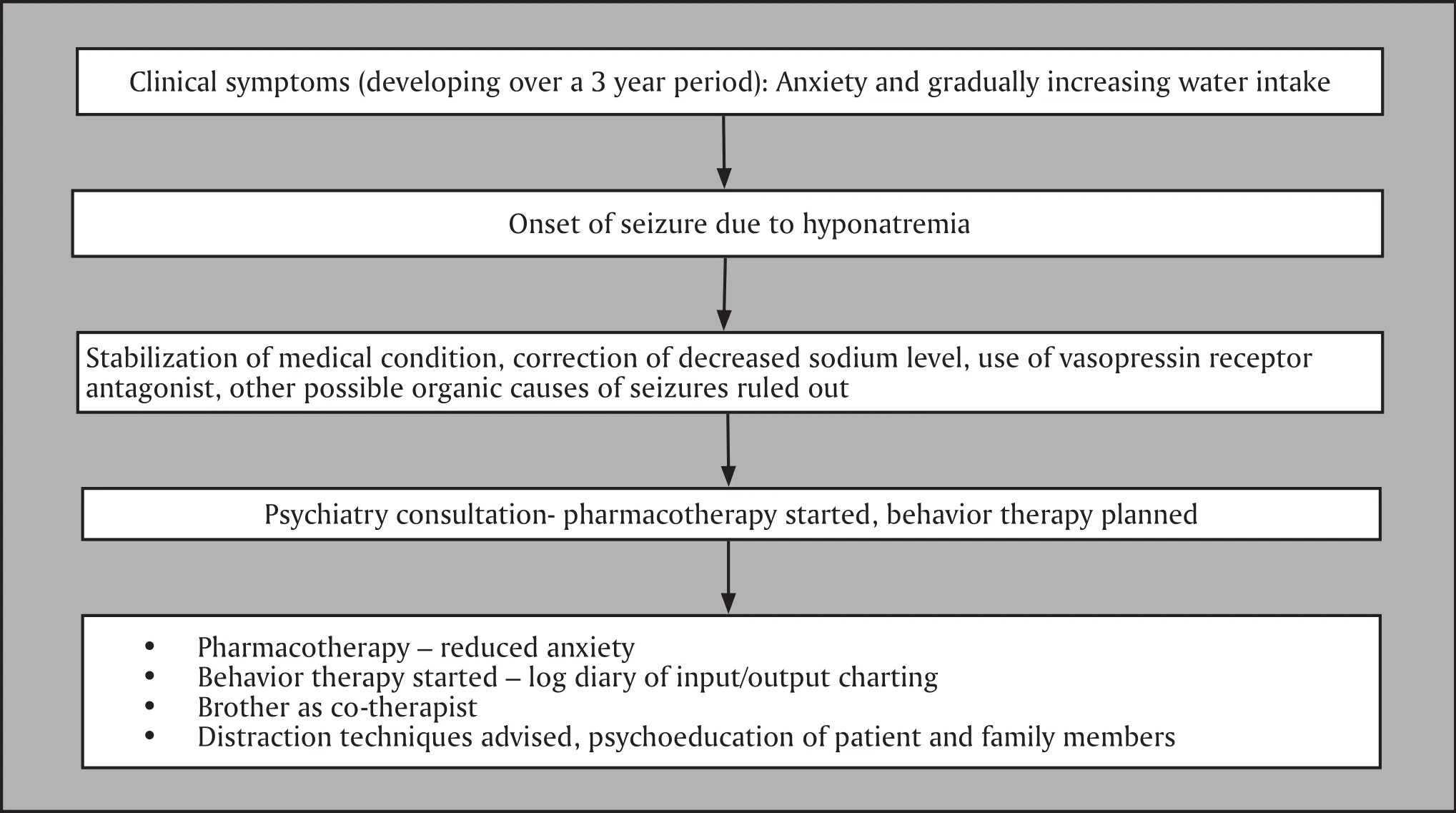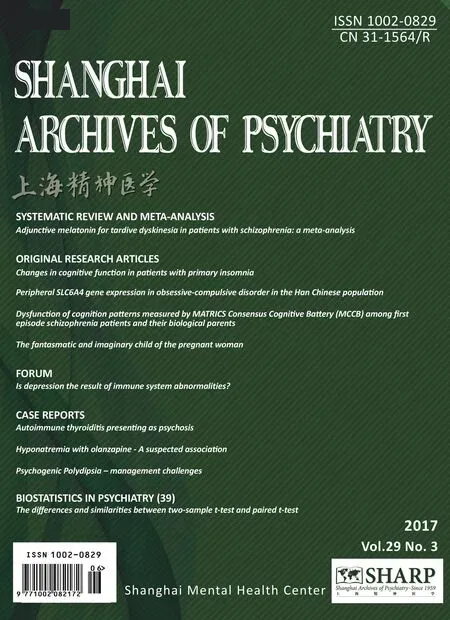Psychogenic Polydipsia – management challenges
2017-11-29BHATIAAparnaGOYALRashmitaSAHANimishaDOVAL
M.S. BHATIA*, Aparna GOYAL, Rashmita SAHA, Nimisha DOVAL
Psychogenic Polydipsia – management challenges
M.S. BHATIA*, Aparna GOYAL, Rashmita SAHA, Nimisha DOVAL
psychogenic polydipsia, hyponatremia, seizure, psychiatric sequelae, anxiety symptoms
1. Introduction
Psychogenic polydipsia (PPD) or self-induced water intoxication (i.e., SIWI) or water intoxication are all used to describe compulsive water drinking. It is now not such an uncommon entity in patients with mental illness but is still underreported and ill defined. In PPD there is a disturbance in thirst control not caused by impairment in production or release of ADH (Anti Diuretic Hormone). The illness generally develops in three phases, beginning with polydipsia and polyuria,followed by hyponatremia (water is retained as the kidneys fail to excrete the excess fluid, resulting in low sodium serum values) and finally water intoxication which may manifest as nausea, vomiting, delirium,ataxia, seizures, and coma, and may even be fatal.Though most commonly seen in patients with chronic schizophrenia, other mental illnesses associated with PPD are affective disorders, psychosis with onset during childhood, mental retardation, personality disorders,and tension/anxiety.[1]Studies have reported that it can affect about 6 to 20 % of psychiatric patients.[2,3]Indian literature is very sparse on this subject, so here we present such a case on psychogenic polydipsia.
2. Case report
A 35-year old adult, high school educated, married male, tailor by occupation, of lower socio economic status presented to the psychiatry outpatient department of University College of Medical Sciences and Guru Teg Bahadur Hospital, a tertiary care center in the capital city of Delhi. He was referred from the medical department for complaints of increased water intake with two episodes of abnormal movements.Abnormal movements were characterized by sudden tightening of limbs and jaws with jerky movements with urinary incontinence and loss of consciousness one month prior to the visit. Patient was evaluated and found to have low serum sodium levels. The jerky movements were attributed to hyponatremia induced seizure due to increased water intake. On elicitation of history from patient, his wife and his brother who accompanied him, reported that patient was apparently functioning well until 2 to 3 years ago when he had an episode of fever following which he started reporting complaints of weakness and anxiety. He reported that he was advised by the doctor to drink fluids, following which he initially started taking increased amounts of water per day and gradually the intake was raised to about 10 liters / day. He started feeling thirsty while talking or after micturition and there was a need to drink water after every five to ten minutes and also,after whenever he passed urine. He reported that he would feel anxious and irritable if he was unable to get water or if family would stop him from taking water.His appetite had decreased and he had suffered loss of weight over the period of 2 years and had thoughts preoccupied with water intake. He would always keep a 2 liter bottle of water with him. He also lost interest in work and stopped going to work, citing weakness and fatigability all through the day as the reason for absenteeism from work. There was no history of sadness of mood or any other depressive symptoms. No psychotic symptoms could be elicited and no other obsessive thoughts, images or impulses or any other compulsive behavior was present. No history of any organic cause was found. History of smoking was present but he was abstinent for the past 2 years. Past and family history was insignificant. No significant medical history was obtained.Premorbid personality was of an extrovert, cheerful,conscientious, religious adult. He was treated with paroxetine 12.5 mg which he had taken for a few days but had reported no improvement in water drinking and had probably increased the risk of low sodium levels leading to seizure. On Mental Status Examination, patient was conscious, oriented, asthenic built, cooperative, had a 2 liter bottle of water which was half filled (he reported to have finished about 3 liters before the visit in about 4 to 5 hours), and he was taking regular sips from the bottle after almost every few sentences, reporting inability to stop drinking water even when asked to,complaining of feeling thirsty as he spoke, psychomotor activity and speech was normal, preoccupations with drinking water, he appeared anxious with no perceptual abnormality. Differential diagnoses included Syndrome of Inappropriate Anti Diuretic Hormone (SIADH), diabetes insipidus, hyperthyroidism, and excess cortisol and psychogenic polydipsia were considered.
Patient’s complete hemogram, thyroid function tests, liver function and renal function tests (except serum sodium), blood sugar, urine routine, CT scan brain were found to be normal. Values of serum sodium were low when he was evaluated at the time of seizure.Mild hepatomegaly and bilaterally mildly enlarged kidney were seen on ultrasound of abdomen. Sodium osmolarity was 145 mosm/kg, urine osmolarity was 285mosm/kg. Cortisol levels were normal. No diurnal body weight gain was noted. These findings rule out the possibility of organic causes and the patient was managed on the lines of psychogenic polydipsia (R63.1 according to ICD-10).
Patient was on treatment initially with vasopressin receptor antagonist (tolvaptan) 30 mg in divided doses which was tapered off after sodium levels were stabilized by the physician. He was started on olanzapine 2.5 mg and clonazepam 0.5 mg for antianxiety effects. Behavior therapy for compulsive water drinking was planned with the patient and brother as co therapist. He was advised to keep a log diary of intake and output for fluids. He was advised to reduce his water intake by keeping a watch on his input/output chart. Family as well as the patient was psychoeducated regarding effects of increased water intake and the need to restrict water intake. This helped family members to stop him from drinking excess fluids even when he would become irritable if restricted. In a span of 6 weeks follow up, he showed remarkable improvement in his water drinking, reduced from 10 liters approx. to 5 liters / day as seen by input /output charting made by the patient and supervised by his family members. His anxiety levels were also reduced and he was motivated and started to go to work. He reported feeling better and motivated for treatment with further reduction in water intake. Patient was advised to gradually stop olanzapine and clonazepam and to continue with behavior therapy (Fig).
3. Discussion
Psychogenic polydipsia may be associated with several psychiatric conditions including psychotic depression,bipolar disorder, and most commonly schizophrenia with up to 18% of patients displaying polydipsic behavior.[4]Hyponatraemia can worsen psychotic symptoms and early signs of sodium deficiency may mimic psychosis or bipolar disorder.[5]The pathogenesis of the polydipsia may be hypersensitivity to vasopressin, an increase in dopamine activity, or a defect in osmoregulation.[6]Evidence suggests that the osmotic set point for vasopressin secretion may be lower in patients with polydipsia and hyponatraemia,leading to impairment in water excretion. Psychological stress and acute psychosis may contribute to this transient resetting of the osmostat.[7]Other postulated hypotheses include stimulation of thirst centers by elevated dopamine levels, drinking to counteract anticholinergic side effects of psychotropic medications, and changes in feedback regulation of the hypothalamic-pituitary axis induced by chronic polydipsia.[8]Still the cause of polydipsia remains unclear.This particular patient was not diagnosed with psychotic sympyoms, but was found to be within the anxiety spectrum that led him to compulsive water drinking. Also PPD remains an underdiagnosed entity and often comes to the attention of a psychiatrist after the onset of complications like seizures, as was seen in this patient. There is some agreement in common areas of diagnosis and treatment interventions (i.e. Clozapine, behavior modification,psychosocial rehabilitation), a consistent treatment approach throughout the years has emphasized PSR strategies such as psycho-education, which has been implemented in various tertiary care settings.[9]A study reported D2-sparing profiles of receptorbinding achieved by risperidone and olanzapine can be beneficial in this.[10]In another review, a number of antipsychotics including olanzapine were reported to be useful in anxiety spectrum disorders.[11] In any case,antipsychotics have very broad pharmacodynamic effects,and many ways in which they could influence anxiety and not necessarily or reliably in a favorable direction. They appear to have complex regionally specific effects on GABA based on in-vitro and animal models. In another study it was reported that olanzapine counteracts stressinduced, anxiety-like behavior in rats via an indirect effect on the GABAergic system. This seems to be mediated by olanzapine’s effects on allopregnanolone, a neuroactive steroid that activates the GABA receptor complex.[12]Because atypical antipsychotics have a lower risk of extrapyramidal symptoms and have an effect on anxiety symptoms (as well as their availability and they are free in our hospital’s pharamacy), we prescribed olanzapine to this patient. With this patient we tried to use a holistic approach in treatment with both pharmacotherapy with olanzapine and behavior management with restriction of fluid intake. An SSRI like paroxetine was found in this patient to exacerbate the hyponatremia and should only be used in conditions where depression is comorbid.

Figure 1. Flowchart depicting evolution of clinical symptoms and management
4. Conclusion
Considering that psychogenic polydipsia is commonly present, especially in psychiatric populations, a regular evaluation into water intake should be done so as to have an early diagnosis and intervention and avoid fatal complications like hyponatremia, seizures and coma.No specific cause and treatment has been identified for compulsive water drinking and therefore further research is needed for better management of such patients.
Funding Statement
Conflict of interest statement
The authors report no conflict of interest related to this case report.
Informed consent
The patient’s father provided written informed consent for the publication of this case report.
Patient informed consent
Written informed consent was obtained from the patient for willingness to share details of his condition for scientific publication and it was explained to him that personal details would be kept confidential.
1. Kohli A, Verma S, Sharma A. Psychogenic polydipsia. Indian J Psychiatry. 2011; 53(2): 166-167. doi: http://dx.doi.org/10.4103/0019-5545.82554
2.Verghese C, de Leon J, Josiassen RC. Problems and progress in the diagnosis and treatment of polydipsia and hyponatremia. Schizophr Bull. 1996; 22: 455–464
3. Evenson RC, Jos CJ, Mallya AR. Prevalence of polydipsia among public psychiatric patients. Psychol Rep. 1987; 60:803–807. doi: http://dx.doi.org/10.2466/pr0.1987.60.3.803
4. Quinn CJ, Iyegha UP, Beilman GJ, Cerra FB. Acute correction of hyponatremia secondary to psychogenic polydipsia. Am J Case Rep. 2012; 13: 69-71. doi: http://dx.doi.org/10.12659/AJCR.882772
5. Gill M, McCauley M. Psychogenic polydipsia: The result,or cause of, deteriorating psychotic symptoms? A case report of the consequences of water intoxication. Case Rep Psychiatry. 2015; 2015: 846459. doi: http://dx.doi.org/10.1155/2015/846459
6. Andrew RD. Seizure and acute osmotic change: clinical and neurophysiological aspects. J Neurol Sci. 1991; 101(1): 7–18
7. Goldman MB. The mechanism of life-threatening water imbalance in schizophrenia and its relationship to the underlying psychiatric illness. Brain Res Rev.2009; 61(2): 210-220. doi: http://dx.doi.org/10.1016/j.brainresrev.2009.06.004
8. Dundas B, Harris M, Narasimhan M. Psychogenic polydipsia review: etiology, differential, and treatment. Curr Psychiatry Rep. 2007; 9(3): 236–241
9. Hutcheon D. Psychogenic Polydipsia (Excessive Fluid Seeking Behaviour). BC Psychologist. 2013; pp: 15−16
10. Kruse D, Pantelis C, Rudd R, Quek J, Herbert P, McKinley M.Treatment of psychogenic polydipsia: comparison of risperidone and olanzapine, and the effects of an adjunctive angiotensin-II receptor blocking drug (irbesartan). Aust N Z J Psychiatry. 2001; 35(1): 65-68
11. Huh J, Goebert D, Takeshita J, Lu BY, Kang M. Treatment of generalized anxiety disorder: A comprehensive review of the literature for psychopharmacologic alternatives to newer antidepressants and benzodiazepines. Prim Care Companion CNS Disord. 2011; 13(2): PCC.08r00709. doi:http://dx.doi.org/10.4088/PCC.08r00709blu
12. Pies R. Should psychiatrists use atypical antipsychotics to treat nonpsychotic anxiety? Psychiatry (Edgmont). 2009;6(6): 29-37
心因性多渴症–治疗挑战
Bhatia MS, Goyal A, Saha R, Doval N
心因性多渴症;低钠血症;癫痫发作;精神后遗症;焦虑症状
Summary: Compulsive water drinking or psychogenic polydipsia is now increasingly seen in psychiatric populations. Effects of increased water intake can lead to hyponatremia causing symptoms of nausea,vomiting , seizures, delirium and can even be life threatening if not recognized and managed early. Here we present a 35-year old adult who was diagnosed with psychogenic polydipsia and was successfully managed with a combination of pharmacotherapy, fluid restriction and psychosocial management.
[Shanghai Arch Psychiatry. 2017; 29(3): 180-183.
http://dx.doi.org/10.11919/j.issn.1002-0829.216106]
Department of Psychiatry, University College of Medical Sciences & Guru TegBahadur Hospital, Dilshad Garden, Delhi, India
*correspondence: M.S.Bhatia. Mailing address: D-1, NarainaVihar, New Delhi, India. Postcode: 110028. E-Mail: manbhatia1@rediffmail.com
to prepare this case report.
概述:强迫性饮水或心因性多渴越来越多见。过度水分摄入会导致低钠血症引起恶心、呕吐、癫痫、谵妄等症状,如不及早发现和处理,甚至可能会危及生命。这里报告的病例是一例35岁心因性多渴症男性患者,通过药物、限制摄水量和心理等整合治疗手段获成功治愈。

Professor Bhatia obtained a bachelor degree of medicine in 1982 from Maulana Azad Medical College in Delhi University and an MD in psychiatry in 1987 from Lady Hardinge Medical University in Delhi University, New Delhi. He is currently professor and the head of the Department of Psychiatry, University College of Medical Sciences and Guru Teg Bahadur Hospital, Dilshad Garden,Delhi, India. He also is an editor of the Delhi Psychiatry Journal, field editor of the Indian Journal of Psychiatry, an Ex-executive member of the Indian Psychiatric Society (North Zone) and the Indian Association for Social Psychiatry, a member of the World Psychiatric Association, World Association of Social Psychiatry, and the World Federation for Biological Psychiatry. His research interests are psychopharmacology, cultural psychiatry, consultation liaison psychiatry, and somatoform disorders.
猜你喜欢
杂志排行
上海精神医学的其它文章
- The differences and similarities between two-sample t-test and paired t-test
- Hyponatremia with olanzapine - A suspected association
- Autoimmune thyroiditis presenting as psychosis
- Is depression the result of immune system abnormalities?
- The fantasmatic and imaginary child of the pregnant woman
- Dysfunction of cognition patterns measured by MATRICS Consensus Cognitive Battery (MCCB) among first episode schizophrenia patients and their biological parents
